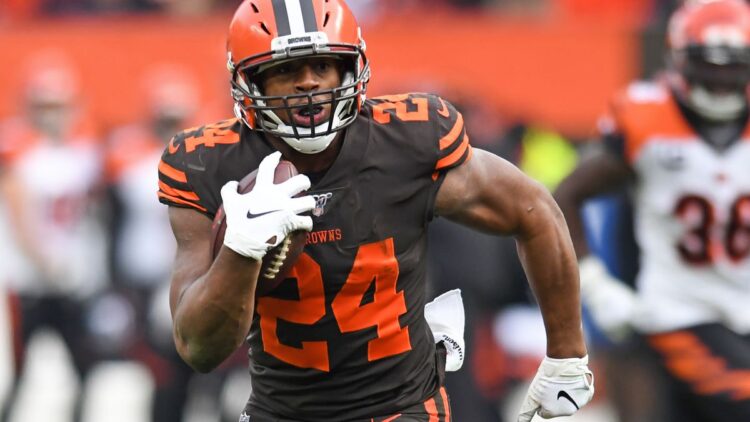
The Cleveland Browns might finally have things headed in the right direction and in large part that’s due to the run game that Stefanski has installed. The Browns run game ranks 1st in the NFL with 942 yards rushing with an average of 188 per game. While Stefanski uses plenty of stretch zone and wide zone, his use of the counter scheme has really powered the Browns run game. With strong and athletic linemen and some very talented backs, Stefanski has helped establish a power, tough nosed, identity in the run game for the Browns. He’ll dress counter up in an infinite number of ways which helps create creases for Chubb and Hunt to attack and allows his linemen to drive block and wall off defenders on the inside. Counter is somewhat of a rarity in the NFL – at least as a bread and butter run play. Defenders are so fast and good at penetrating, they can often disrupt the play if the timing isn’t there. That’s why Stefanski is using his fullbacks, H-backs, and any other personnel he can find to make counter hit faster and more cleanly open up space.
Note: If you prefer to watch a video breakdown, scroll to the bottom of this article.
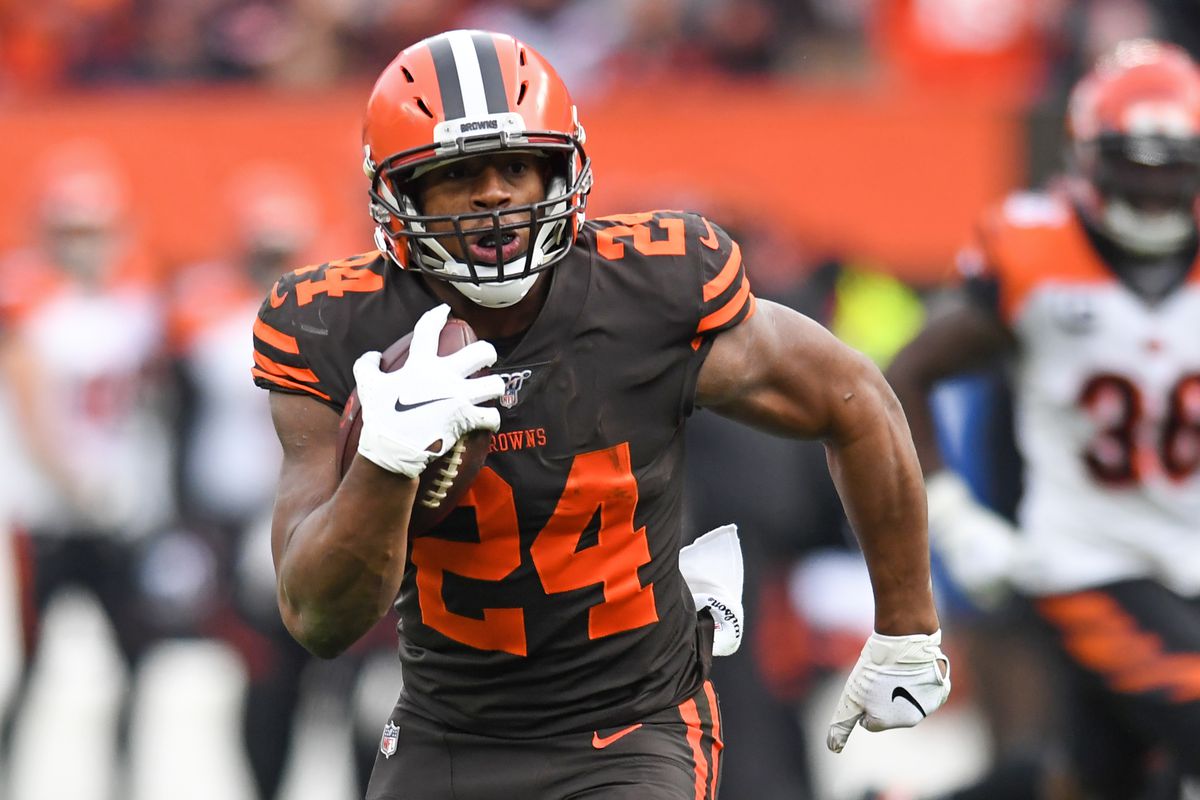
We’ll start off with their pure counter look before we dive into how Stefanski likes to add wrinkles and make his counter look slightly different from play to play. When they’re running their generic guard and tackle counter, they like to run counter strong so that they know that they’re going to typically be running at the 3-technique that is lined up on the outside shoulder of the guard which in turn, makes the down-block for the center easier because he’s now facing a 1-technique that is shaded on his backside shoulder.
In counter, the guard kicks out and the tackle is the one that wraps through and up-field. Usually if there’s an end, that’s the guy that’s left for the kickout but since the Browns here are in 12 personnel with two tight ends and the end is in a 6 technique head up with the first tight end, the guard has to be able to sift through and kick out the first outside man that appears that is trying to pinch down on the hole. That ends up being #58 at the Mike linebacker position. The guard wants to kick him up and out and then the tackle coming behind him, is meant to wrap up and through that kickout block and block the first enemy color. It can depend on the scheme and leverage of the end man on the line of scrimmage, but the tackle will usually look inside out as they wrap through.
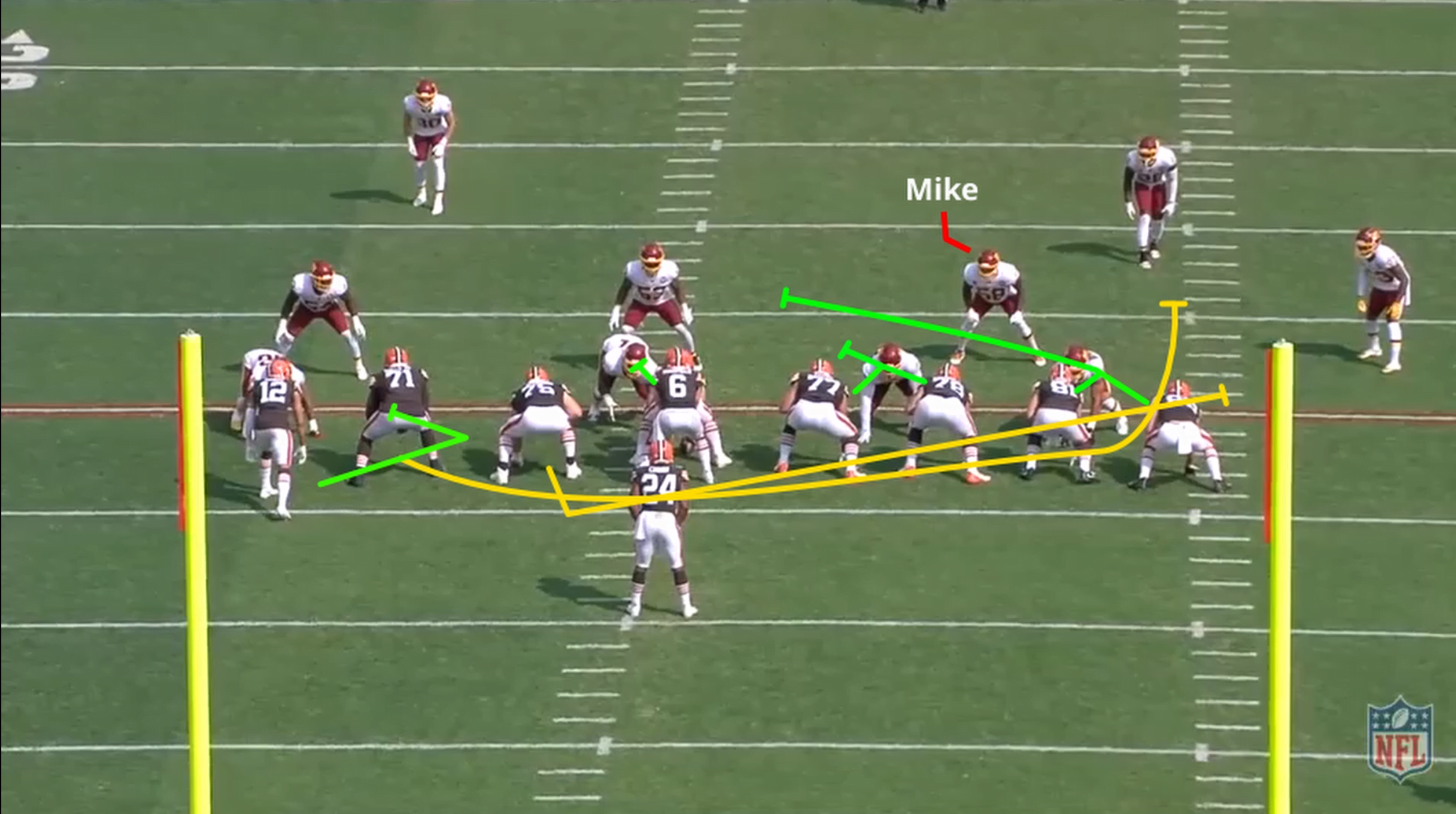
Everyone else is down-blocking. The rest of the line trying to create a wall that prevents penetration and pursuit to the play-side. So, the two tight ends are down-blocking on a combo to the Will linebacker – meaning they’re leaving the Mike for the guard or tackle to pick up. The play-side guard and tackle are also double teaming and trying to climb but the defensive tackle here does a good job anchoring and preventing that. The center walls off, and the receiver in the tight split just tries to get in front of any backside pursuit and slow it down. Chubb does a good job of being patient here and riding his blocks up-field.

So, that’s counter at its core. A guard kick, with a blocker wrapping behind with down-blocks and double teams from the play-side. Let’s now take a look at the variations that Stefanski runs with the Browns – because there are quite a few. The simplest next variation is a guard and H-back pull. The Browns block it slightly differently on this snap than your conventional counter though. The kickout is now designed to be on the linebacker because the play-side tackle is hinging and blocking the defensive end. With no end man on the line of scrimmage to kick out, the pulling guard is now responsible for kicking out the play side linebacker. The H, who is replacing the role of the tackle, is looking inside to block the flowing backside linebacker. As a result, the counter hits a lot more vertically and tighter to the center of the field.
You can see comparatively how this is a harder block now for the center because they’re running counter weak, away from the H back. They’re doing this though because they want that open B gap on the play side. So, the play side block for the guard is much easier on their down-block on a 1 technique which helps prevent penetration. If that player was in a 3-technique, as we’ll see soon, the play would be run like a normal counter because they wouldn’t be able to down-block a potential 3 tech there and still be able to block the end. Because the guard isn’t kicking out the end, he has to know he has to be really tight to the line of scrimmage here because he can’t over run that linebacker that’s going to fill the B gap. It’s not perfect because he gets the up-field shoulder of the linebacker, but it’s effective enough to create movement and space. The H wraps around looking inside for the flowing linebacker, and Chubb again does a good job running tight to the wrap block and bursting up-field off of it.
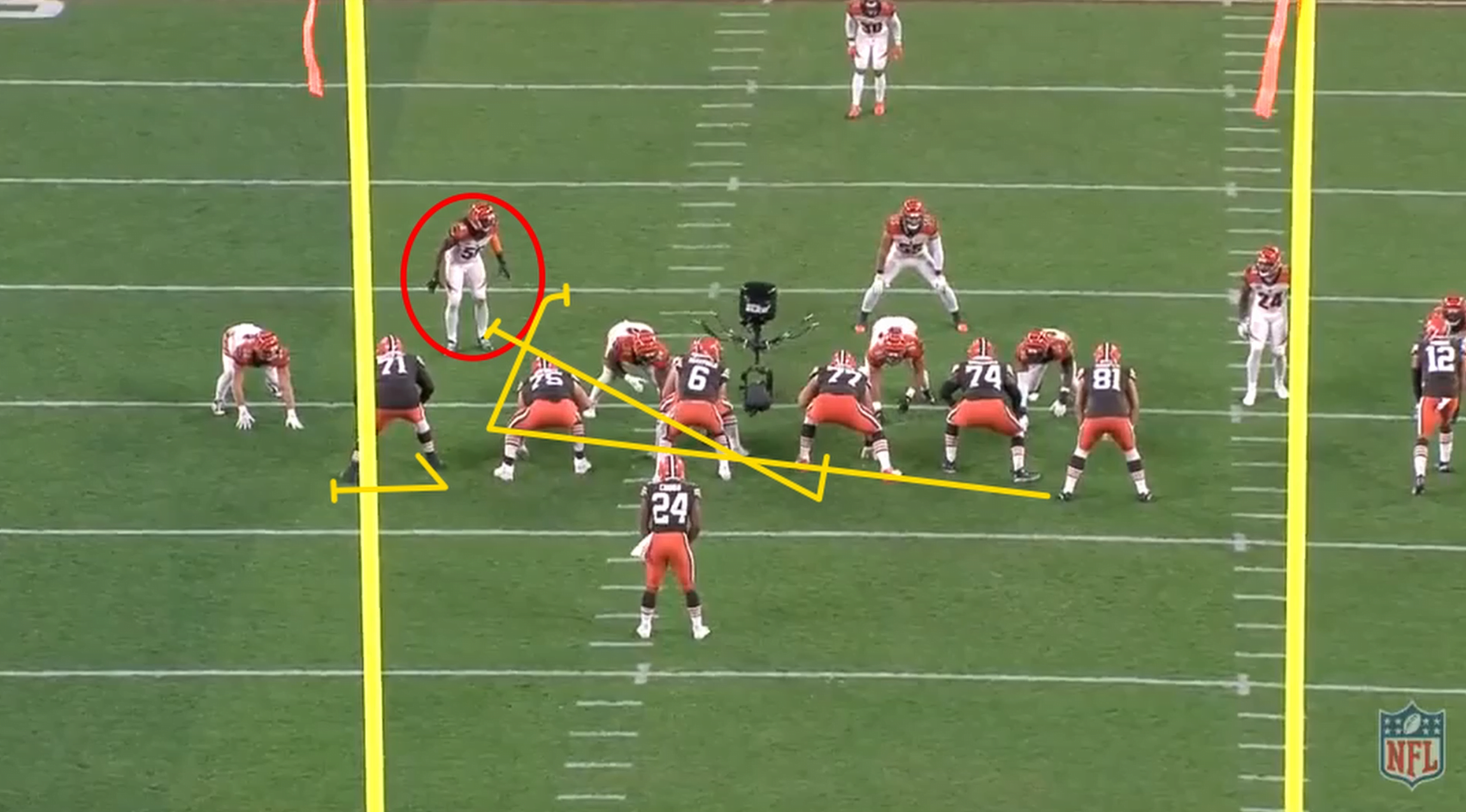

As a comparison, you can now see that same concept run against the Bengals when they have a 3 tech to the play side. The left tackle now down blocks on the 3 technique, and the guard wraps around him. The Browns in both these cases used a jet motion – which, to be honest, they could stand to do a lot more of.
A lot of data is indicating that plays run with pre-snap motion have a higher expected point value on them than plays that don’t. Stefanski was notoriously bad with that with the Vikings last year and ran motion on only 5% of plays and it’s not much better this year. You can see though how impactful that motion is, because it forces the end man on the line of scrimmage out of the play. The guard is now able to wrap up to the linebacker, the H follows behind looking inside first, and while that player that the motion originally moved ends up making the play, it’s not until they’re already 10 yards downfield.
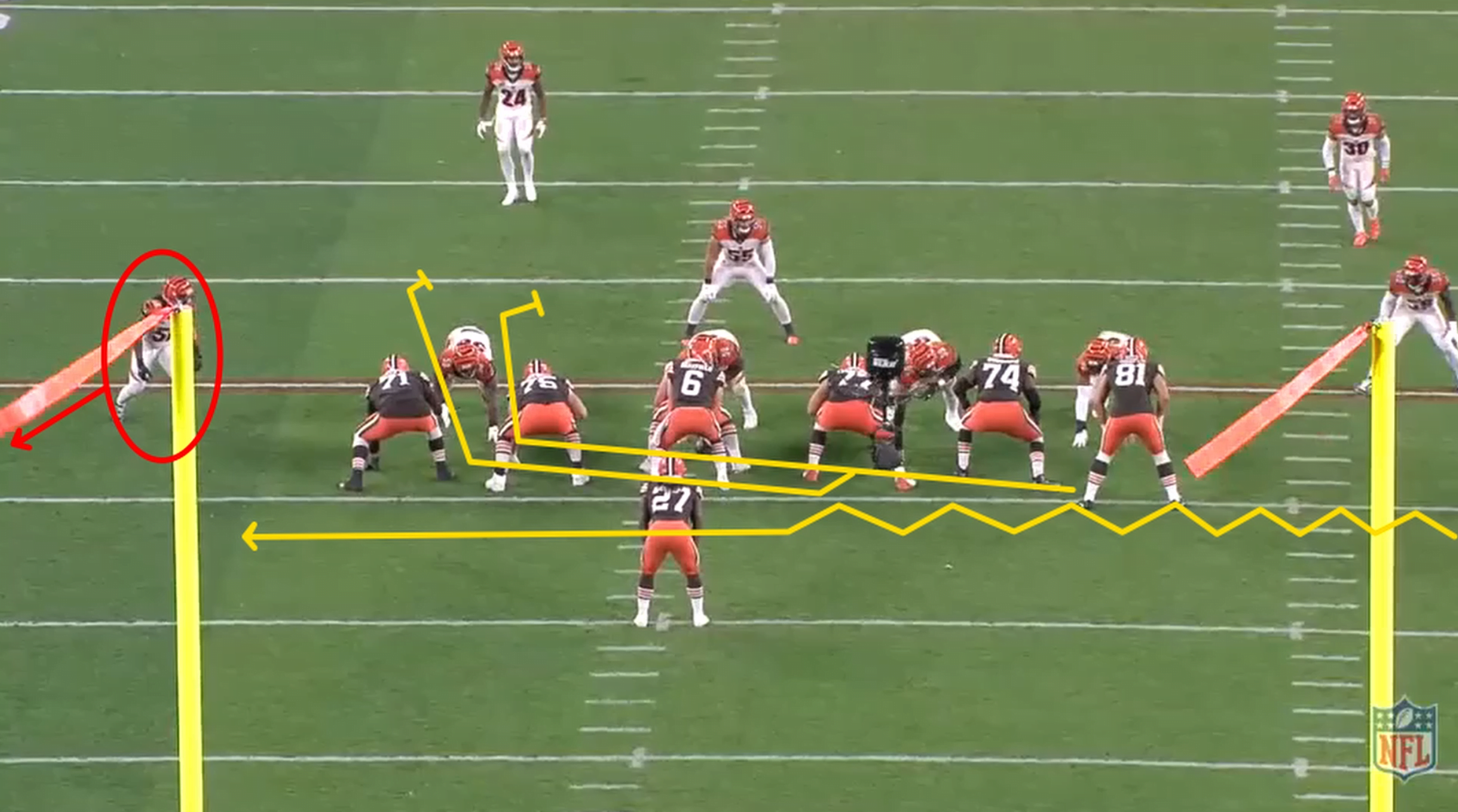

Stefanski and the Browns run game will also really change it up and mess with linebacker reads by pulling the play side guard instead of the backside guard and run counter with a fullback. It’s almost like a wide trap that can hit very fast with the kickout from the guard and then a more athletic pulling fullback coming across the formation to wrap through. All the staples of counter are there though. You have the down-blocks and climbs to linebackers creating a wall, you have the kickout, and you have the wrap through. Because they’re running at a 3-technique, the the fullback knows that the guard is going to kick out the end man on the line of scrimmage (EMOLS) and that the tight end is going to be able to easily climb to the linebacker based off of alignment. So, the fullback is now looking outside in and picks up the corner that’s walked down into the box. Everything works as schemed and Kareem Hunt is able to get a really nice gain off of it.

They’ll even occasionally have their fullback kick out the EMOLS and have the guard wrap through. Yet another small wrinkle to get to counter but make it look a little different.

Before going into the Browns last couple forms of counter, it’s important to look at their wide zone, because they work off of each other. Wide zone and stretch zone are essentially the same play and it’s largely semantics, but the Browns like to run them both. It gets linebackers flowing and creates cutback lanes for their running backs. They’ll run naked boots off of it and play action and it can be a super effective play for them.
This is an example of stretch zone. Really the defining characteristic for me, and the difference between this and wide zone, is the play side tackle and the size of horizontal steps by the rest of the line. If the tackle is trying to lead with and wrap his hips to seal the outside, I call it stretch. It’s a slight philosophical difference in how the play is run. You can see the tackle is working to seal the outside and allow the running back to turn the corner, which he does successfully. The rest of the linemen are taking hard horizontal steps and working to overtake and climb to linebackers to create hard flow and cutback lanes for the running back when linebackers over pursue.
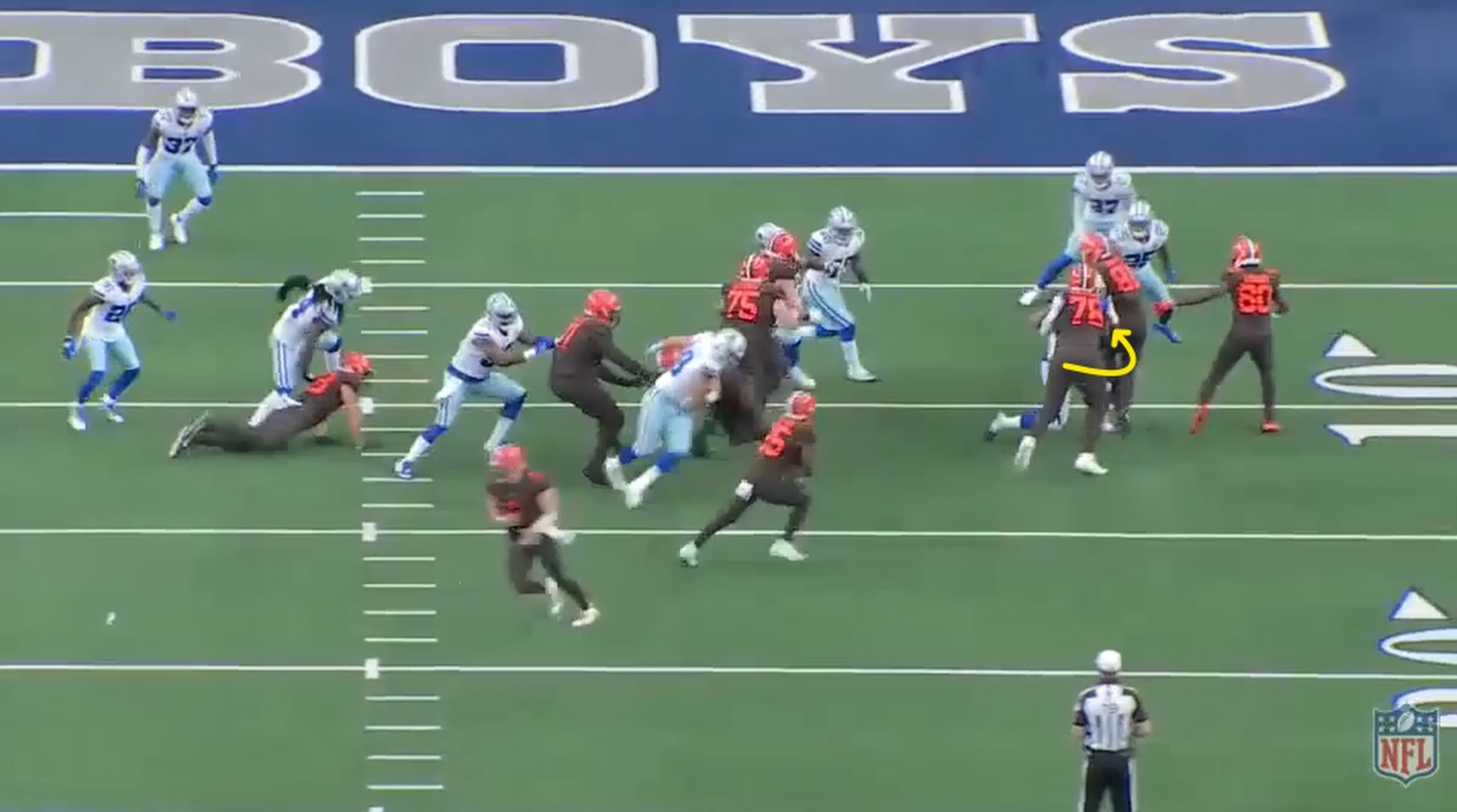

The ball might not always go outside, but that’s the goal of stretch zone. They really want to create hard flow and stress the edges and are willing to be a little more vulnerable to some inside penetration to do so.


Compare this now to wide zone, where you have a similar alignment from the end man on the line of scrimmage, but now the tackle is just drive blocking him out of the way. He’s not as concerned with sealing the end and is okay with the play cutting up underneath him. The rest of the line takes slightly less aggressive horizontal steps but otherwise stay on the same tracks as the stretch zone.

The main reason I wanted to show some of their wide and stretch zone is to show how the flow works on the offensive line and what that causes in the defense. They’ll often throw in a fullback and have him lead block on their zone plays as well. He just takes the same track as if he was a running back, reading outside-in on the defensive linemen and then attacks the first linebacker to appear and acts as a lead blocker.

Now that we’ve seen how the Browns run game uses the wide and stretch zone and even incorporate lead blocks with the fullback into it, we can go back to our counter. The Browns will run that same look with the outside zone lead, and now they’ll pull that fullback around on a counter action and wrap just like we were seeing before with the H. He takes steps forwards like he’s lead blocking, the down-blocks from the line look an awful lot like wide zone steps and reach steps, but now the guard and fullback are coming around on counter. The guard kicks out and the fullback wraps through.
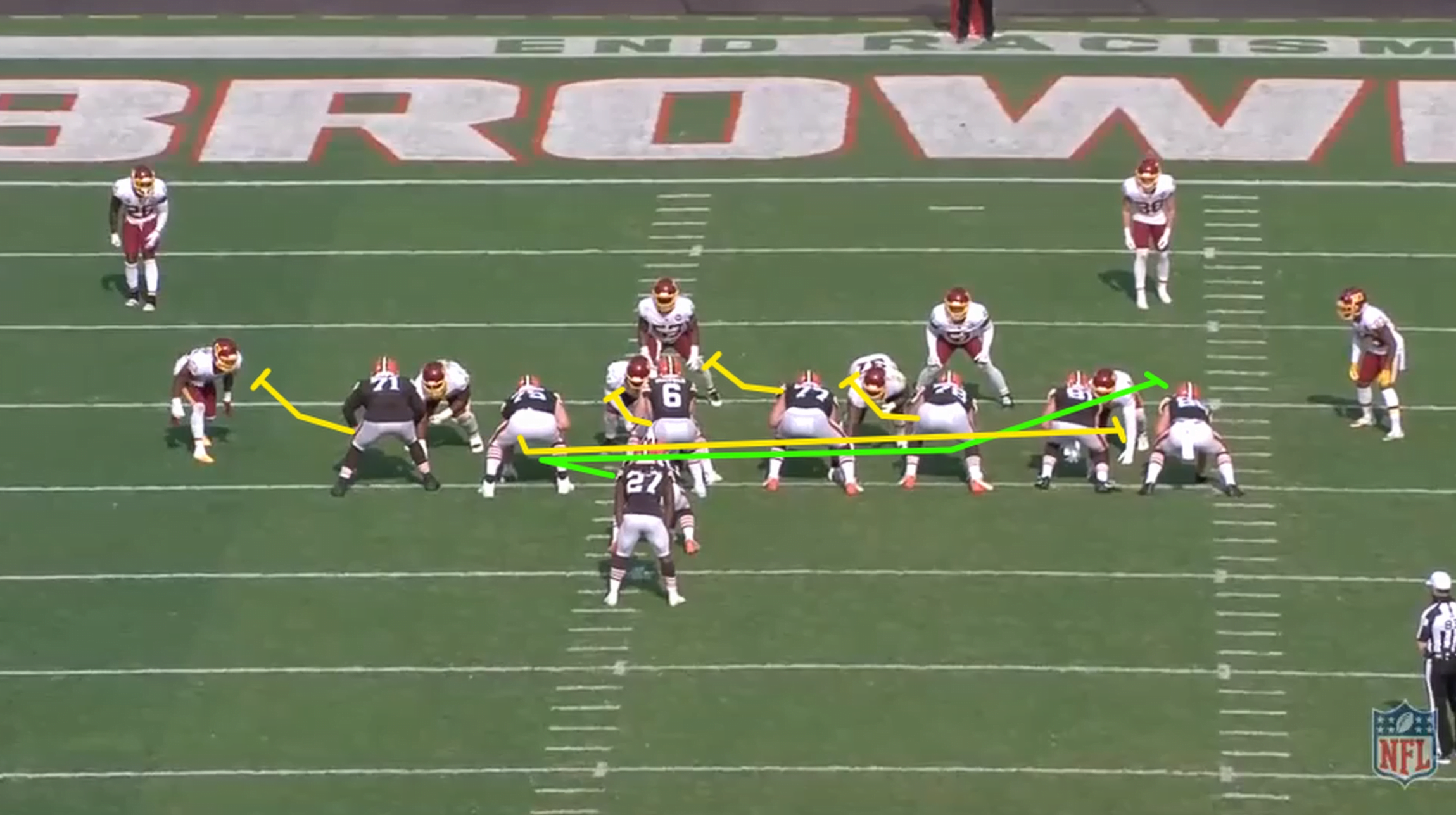

This is the same concept but a great illustration of how this looks similar to wide zone and gets the linebackers out of position. Again, we have the fullback fake lead to counter wrap and the guard kicking out but take a look at all the linebackers taking a step the wrong way. Because they establish the wide zone and wide zone fullback lead, the linebackers react to it and are out of position. They get caught in traffic trying to scrape across, you have two lead blockers going the other way and there’s one poor corner who’s supposed to take on a kickout block from a guard. Not a recipe for success for the defense.

The Browns also have a guard center counter that they’ll run that can really force defenses to flow hard to the wide zone look and can also be read similarly from the running back perspective. It’s really the same concept we’ve been going over. Just now we have the play side guard and center working the counter action. Guard kicks out, center wraps through. It does make for some incredibly tough blocks on the backside though. It’s a big ask to cut or wall off pursuing defenders so it’s been a little hit or miss for them but when it hits, it can hit big.
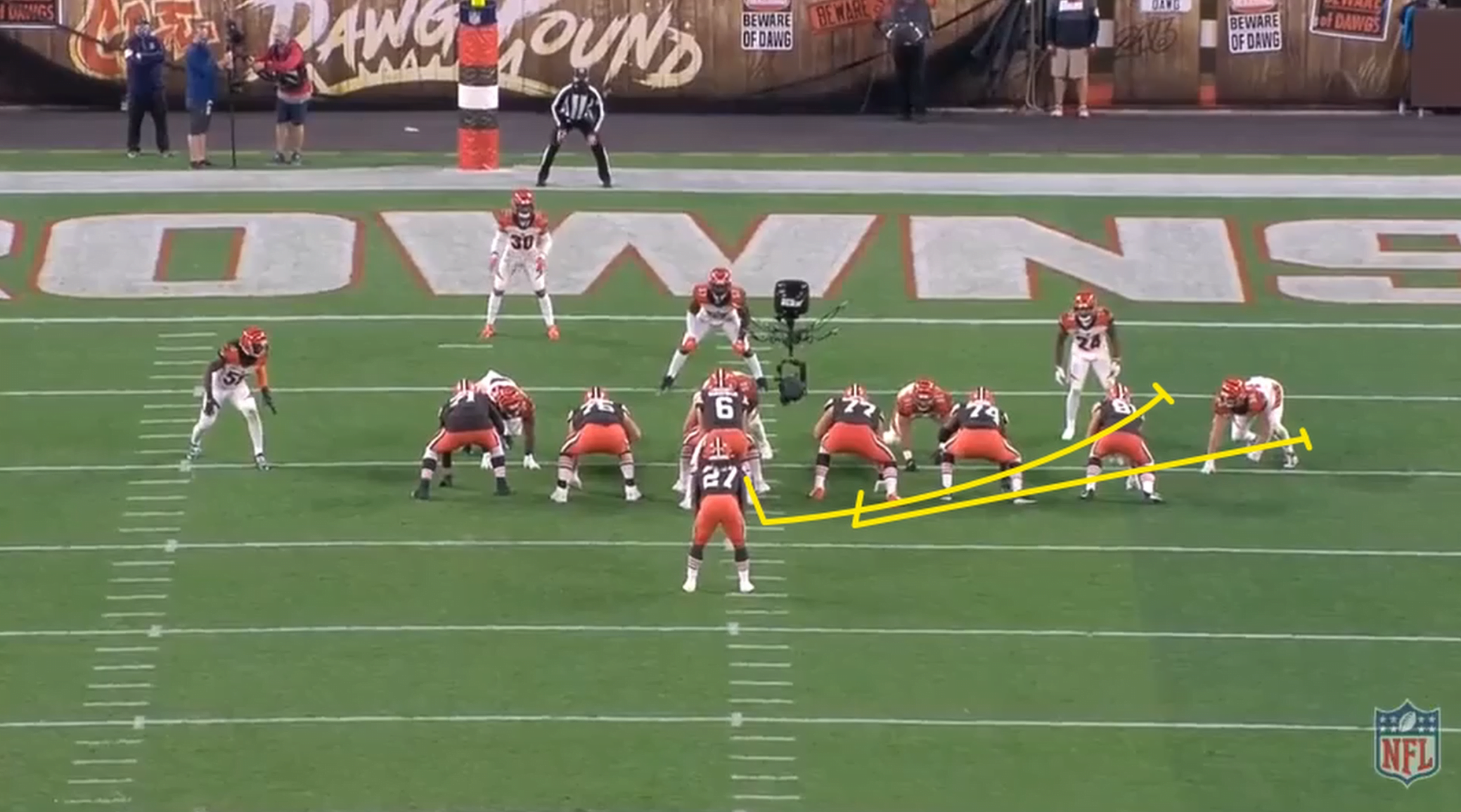

What’s cool is that when they don’t go for the cut blocks backside to prevent pursuit, the play can turn essentially into wide zone. If the defense over flows to the two pullers and the stretch and cutoff blocks, the running back can cutback to the backside just like we see in wide zone. Some really interesting little wrinkles and shows how the scheme is all tying together for the Browns run game. The plays build off each other to look similar and keep similar concepts, they’re just designed with slight tweaks and differences.

To finish things off quickly, we’ll talk about that game winning end around to OBJ that the Browns called to beat Dallas because it works off these same concepts. It’s a gotcha play two rungs up the ladder. The Browns run wide zone, they run wide zone fullback lead, then they have the wide zone FB counter wrap play, and now here they are running the counter H-back look except the H-back is now wheeling back around and lead blocking for the end around to Odell Bekham Jr. They still pull the guard and give the Cowboys every indication it’s another one of their power looks and the linebackers buy it and get out of position. They ran it earlier in the game and got a good chunk out of it.


The Browns run game is grinding people out right now. Even though Nick Chubb is down for a few weeks, Cleveland just keeps on running it down people’s throats. They are pretty versatile in their game plan and will be heavy zone one week and heavy power and counter the next but the beautiful thing is that it all ties in together. Stefanski has found a way to mesh them into one identity. An identity of aggressive, powerful, and tough football. A team that can grind away your will on the ground and make things easy for Baker Mayfield and some absolute top tier weapons in Odell Bekham Jr, Jarvis Landry, and even Austin Hooper. If you can’t stop the run of the Browns, it’s going to be a long day. The Browns won’t stop running until you make them and if things continue like this, they may keep running all the way to the playoffs.
If you liked this post make sure to subscribe below and let us know what you think. If you feel like donating and want access to some early blog releases and exclusive breakdown content or to help us keep things running, you can visit our Patreon page here. Make sure to follow us on Instagram @weekly_spiral and twitter @weeklyspiral for updates when we post and release our podcasts. You can find the Weekly Spiral podcast on Spotify or anywhere you listen.
